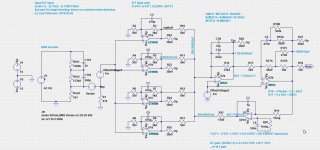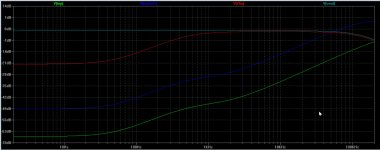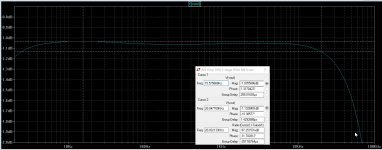In the last few years or so, some rather high-end mm/mc pre-apms have emerged.
Fancy designs with some of the best OP-Amps available, some only in SMD packages. Parts that is either rather expensive, hard to obtain from your local parts-pusher, or both.
So I thought, why not design a RIAA from parts that are easy to source at a reasonably low price, or that you might allready have in your parts-bin ?
A design that would maximise the sound quality from the parts given/chosen.
Maybe even dispens with dc-blocking (expensive) capacitors in the signal path?
I am talking of OP-AMps like TL07x, MC33078, LM347, LM833. They are old designs, but very inexpensive. They do have som shortcommings, compared with LM4562 or newer audio-amps:
Noise:
------
As long as we only consider those amps labeled "audio", noise is really not a
problem. The only way to reduce this problem (further), is to have two or more amps in parallel in the first stage.
Common mode distortion:
-----------------------
This is a problem in the input-stage of virtually all the amps considered here, and the solution is to use inverting configuration, whenever possible.
Output distortion:
------------------
There really are two problems here: cross-over distortion and drive (in-)capability. The latter is really easy to avoid/reduce and that is to never
load an OPAmp beyond its specification. The first problem (cross-over) can be reduced by sinking from or sourcing into the outout a small dc-current, forcing the OPAmp to work in class A (preferably) at all times.
No capacitors in the signal path and a total dc-gain of app 60dB, makes it necessary to include a dc-servo to keep the output close to zero.
With no capacitor in the input, OPAmps with BJT in the input is out of the question for the first stage, so it will have to be an OPAmp with FET in the input.
The last defense against evil distortion, is not to exceed app 20dB gain in each stage.
The circuit:
------------
Looking at the schematic, the design starts off with a TL074 with all 4 amps
working in parallel to reduce the input noise with 6dB.
The second stage is inverting and implements the 75uSec time-constant.
The third stage is also inverting and implements the 318uSec and 3180uSec time-constants.
Below these is the servo amplifier that maintains the output at zero volt
(I used an UA714 which is an OP07 wanna-be).
The resistors R22 to R27 bias the outputs of the OP-Amps into class A. I probably should have used smaller resistors to get a larger bias current.
I have not used any fancy components, except 1% metalfilm resistors.
The capacitors are standard MKT or similar, which I have measured and matched across the two channels.
Sound.
------
Well, I have to admit, I'm not blessed with golden ears. Having said that, I find it not bad at all, specially considering the price: 8$ max (components only)!
For the record (pardon the pun): I used a Beogram TX (tangential arm) with
a MMC4 (eliptical, 3mV) cart and Sennheiser Momentum closed headphones.
Recently I gave my self an early Christmas present: A Rega RP3 equipped with an Ortofon 2M Black, probably one of the best MM carts. Details emerged, that I didn't know were present in the vinyl: bliss!
I don't do PCBs, I just use Veroboard (160 X 100mm).
Fancy designs with some of the best OP-Amps available, some only in SMD packages. Parts that is either rather expensive, hard to obtain from your local parts-pusher, or both.
So I thought, why not design a RIAA from parts that are easy to source at a reasonably low price, or that you might allready have in your parts-bin ?
A design that would maximise the sound quality from the parts given/chosen.
Maybe even dispens with dc-blocking (expensive) capacitors in the signal path?
I am talking of OP-AMps like TL07x, MC33078, LM347, LM833. They are old designs, but very inexpensive. They do have som shortcommings, compared with LM4562 or newer audio-amps:
Noise:
------
As long as we only consider those amps labeled "audio", noise is really not a
problem. The only way to reduce this problem (further), is to have two or more amps in parallel in the first stage.
Common mode distortion:
-----------------------
This is a problem in the input-stage of virtually all the amps considered here, and the solution is to use inverting configuration, whenever possible.
Output distortion:
------------------
There really are two problems here: cross-over distortion and drive (in-)capability. The latter is really easy to avoid/reduce and that is to never
load an OPAmp beyond its specification. The first problem (cross-over) can be reduced by sinking from or sourcing into the outout a small dc-current, forcing the OPAmp to work in class A (preferably) at all times.
No capacitors in the signal path and a total dc-gain of app 60dB, makes it necessary to include a dc-servo to keep the output close to zero.
With no capacitor in the input, OPAmps with BJT in the input is out of the question for the first stage, so it will have to be an OPAmp with FET in the input.
The last defense against evil distortion, is not to exceed app 20dB gain in each stage.
The circuit:
------------
Looking at the schematic, the design starts off with a TL074 with all 4 amps
working in parallel to reduce the input noise with 6dB.
The second stage is inverting and implements the 75uSec time-constant.
The third stage is also inverting and implements the 318uSec and 3180uSec time-constants.
Below these is the servo amplifier that maintains the output at zero volt
(I used an UA714 which is an OP07 wanna-be).
The resistors R22 to R27 bias the outputs of the OP-Amps into class A. I probably should have used smaller resistors to get a larger bias current.
I have not used any fancy components, except 1% metalfilm resistors.
The capacitors are standard MKT or similar, which I have measured and matched across the two channels.
Sound.
------
Well, I have to admit, I'm not blessed with golden ears. Having said that, I find it not bad at all, specially considering the price: 8$ max (components only)!
For the record (pardon the pun): I used a Beogram TX (tangential arm) with
a MMC4 (eliptical, 3mV) cart and Sennheiser Momentum closed headphones.
Recently I gave my self an early Christmas present: A Rega RP3 equipped with an Ortofon 2M Black, probably one of the best MM carts. Details emerged, that I didn't know were present in the vinyl: bliss!
I don't do PCBs, I just use Veroboard (160 X 100mm).


